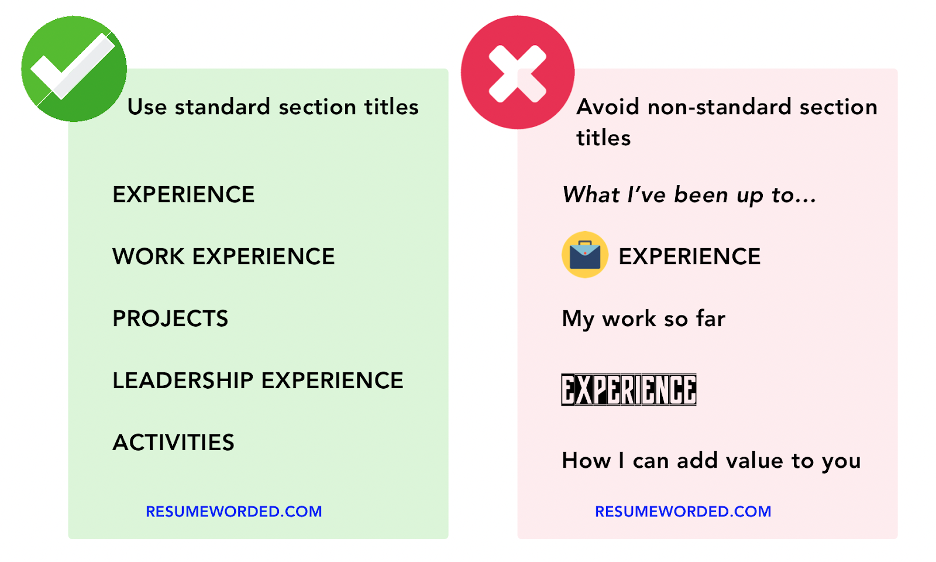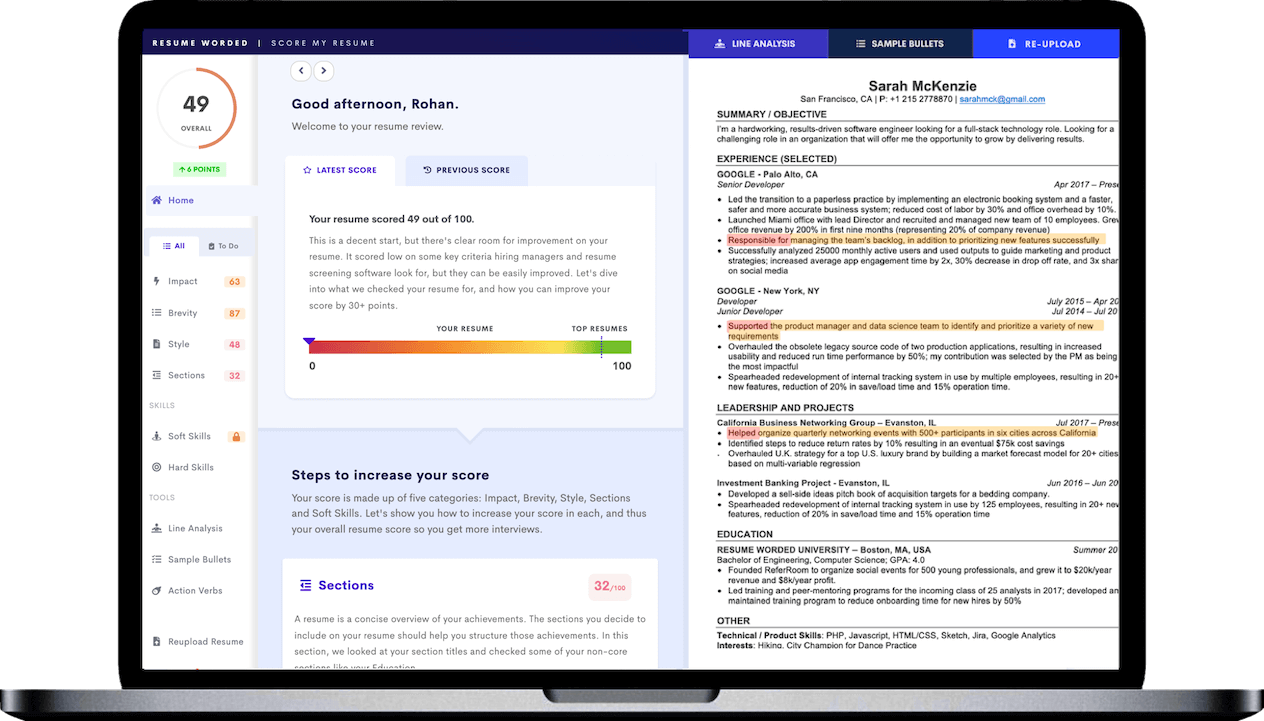In the competitive job market of 2025, it's crucial to have a standout resume that catches the attention of potential employers. But with so many resume formats and tips out there, it can be challenging to know what works best. This article outlines the most up-to-date practices for crafting a winning resume that bypasses automated applicant tracking systems (ATS) and compels recruiters to call you in for an interview. From the classic formatting rules to the three standard resume formats (reverse-chronological, functional, and combination), to examples of what a resume should look like in 2025, this article covers everything you need to know to create a resume that lands you your dream job.
Keep it classic on your resume
Many recruiters are turned off by excessive design. As a result, the structure of your resume is another factor to consider when crafting a winning application. Ultimately, deciding what works best to convey your professional and life story to your audience is up to you.
Formatting your resume to highlight relevant skills and experience is another critical consideration. They must be emphasized throughout the paper and given ample room to shine.
Here are some rules you should follow to ensure your resume meets the expectations of employers in 2025.
- Use a font size of 10–12 points consistently.
- When crafting your resume, one of your top priorities should be ensuring it is straightforward to read. Select a classic, legible font, such as Cambria, Georgia, Calibri, Helvetica, or Arial. Avoid using Broadway or Magneto, which are both very artistic fonts and fonts that are too small and simple.
- Make sure your resume has 1-inch margins on all sides.
- Use appropriate line spacing and a sufficient amount of white space. Your resume shouldn't appear crammed with information.
- Use a single-line or 1.15-line space for the entire resume.
- Maintain uniformity in formatting (e.g., use the same font, line spacing, size, and date format throughout) to facilitate the recruiter's search for specific information.
- No pictures or graphics. Your resume will be rejected by ATS software if you use graphics, and you should only include photos if specifically requested to do so.
- Write your resume in clear, standard sections. Use "Work Experience" rather than "work history" or any other unwieldy term to describe your previous employment.
- Use bullet points to briefly summarise your work experience, responsibilities, education, awards, etc. A resume with these elements is much easier on the eyes.
- Write concisely to increase the amount of white space in your resume.
- Resumes should not exceed one page in length. There is no need for a three-page document unless you have over ten years of experience in your field.
- Create a PDF version of your resume. It's the safest option because it preserves your resume's format regardless of the device used to open it.
If you are not sure whether your resume is formatted correctly, upload it to the tool below. It will scan and score your resume on key criteria such as font size and style, margins, line spacing, section titles, and resume length.
What a resume should look like in 2025 – The 3 standard resume formats
After reviewing all the fundamentals, let's get into the specifics of resume formats.
It would be best to first understand that there are three resume formats to choose from, namely:
- The reverse-chronological resume format
- The functional resume format
- The combination resume format
Now that you know your options, it's time to figure out which is best for you. Let's see how to select the most appropriate format for your needs, goals, expertise, and career field.
Reverse-chronological
This is the best and most widely used format for a resume. Highlighting your most recent job first and listing the others in reverse chronological order draws attention to that part of your resume.
This resume format is recommended if you have a consistent work history, are applying for positions similar to your current one, are just starting your career, or are in the academic field.
Resume Structure
- Personal Information (Name, title, phone number, email)
- Resume Summary
- Work Experience
- Skills
- Education
- Other sections
Example
Pros
- HR managers and recruiters prefer this format.
- Gives a clear and concise account of your professional background in reverse chronological order.
- Demonstrates growth in knowledge and responsibilities.
Cons
- To get a recruiter interested in you, you must highlight the results you've obtained in previous jobs.
- Hard to fill out if you've never worked.
- highlights employment discrepancies
Functional
The purpose of the functional, or skills-based, resume format is to highlight your competencies and academic credentials rather than your work history. This is ideal if you have gaps in your employment history, frequently switch jobs, work in creative fields, and do not want to come across as overqualified.
Resume Structure
- Personal Information (Name, title, phone number, email)
- Resume Summary
- Skills
- Work Experience
- Education
- Other sections
Example
Pros
- Helps showcase your unique set of skills.
- Helps describe how your experience applies to a new field of work.
- Ideal for the recent college grad who has a knack for the practical world but lacks substantial work experience
Cons
- Because there is no clear indication of when and where the applicant has worked, potential employers view them with suspicion
- It only shows a small portion of your professional history.
- Functional resumes are difficult for ATS to read.
Combination
It combines traditional chronological and skills-based functional resumes, emphasizing your work history and abilities. This is ideal for you if you are an experienced worker looking to make a career change, fill employment gaps, or pursue a particular position.
Resume Structure
- Personal Information (Name, title, phone number, email)
- Resume Summary
- Skills
- Work Experience
- Education
- Other sections
Example
Pros
- Reduces potential drawbacks like joblessness and lack of relevant experience
- Feature your most impressive qualifications and experiences.
- Integrates knowledge from several fields or experiences
Cons
- It starts looking like a mess really quickly.
- Preparation calls for more creativity and effort.
- Downplays job duties and responsibilities.
What a resume should look like in 2025 to bypass ATS
Applicant Tracking Systems are something you've likely heard of if you're applying for jobs these days. Many firms use these scanners to review applications quickly before reaching a human recruiter.
These platforms have rapidly replaced traditional methods for sourcing new employees online at major corporations. An applicant tracking system (ATS) will examine your resume whenever you submit it through an online application system. It's good that applicant tracking techniques are automated because they can be easily defeated with some optimization.
Here is how you can bypass ATS.
Focus your resume on the position you're interested in getting
You won't want to keep sending the same resume to different companies since you'll customize it based on the keywords. Not only is it more challenging to get past the applicant tracking system (ATS) if your resume doesn't contain the exact keywords from the job posting, but recruiters can tell for sure that you're just sending out a generic document. And it shows that you don't value working for that particular company.
Consider using the job description's keywords
Automated testing systems (ATS) scan resumes for a predetermined list of keywords, so they are easy to trick as long as you are using the right kind of words to show off your expertise and experience. These automated systems scrutinize the job description, paying particular attention to the hard skills mentioned early on.
"Hard skills" refer to more tangible abilities, such as knowledge of specific software, methods, or languages. The name of the position itself may be the most important search term.
Moreover, if you're applying for a job that requires a state license, like nursing or teaching, the hiring manager will want to see evidence immediately that you're qualified to do the work.
The key is to strike a balance; you don't want a resume so crammed with keywords that it's immediately dismissed. If you're having difficulty determining the crucial job description keywords, our tool Targeted Resume will help you look for pertinent keywords in the job description and create an ATS-friendly resume.
Make a pdf copy of your resume
A PDF file is the preferred format for submitting a resume.
Why?
You probably put in a great deal of time to ensure your resume looks its best, and you don't want to risk ruining your hard work by using an older or newer version of Word. It is also easier to distribute, as potential employers and recruiters will not need the Office suite to view your resume in PDF format.
When is it not a good idea to use PDF for your resume? When you need to send it in a specific format, like Word or Google Docs. It's always more important to do as you're told.
Toss out any charts and graphs
Even if you're applying for a position in graphic design and want to make a resume that stands out visually by including lots of charts and visuals, it's best to keep things as straightforward as possible. The hiring manager may be interested in a unique-looking resume, but you must pass the applicant tracking system first. However, complex resumes can be a headache for some applicant tracking systems, leading to misplaced information.
Make use of standard font sizes and bullet points
Choose a simple, easy-to-read font throughout your resume, like Arial, Times New Roman, or Georgia. Additionally, to draw attention to a particular point, use bullet points and underlined or bolded words rather than charts or other graphical elements.
8 examples of what a resume should look like in 2025
- Basic - A clear, well-organized, and uncluttered layout that's a joy to read.
- College student - Offer concrete examples of your abilities to potential employers.
- No experience - Since you lack any work experience, make your education, extracurricular activities, volunteer work, and personal experiences the focal point of your resume.
- Career change - Take advantage of your training and experience. Since you don't have relevant work experience, you'll need to highlight your transferable skills instead.
- Entry Level - Show the hiring manager you are a good fit for the job by highlighting your relevant qualifications.
- Executive - Feature your qualifications prominently near the beginning of your resume, and consider adding subheadings for things like certifications, awards, memberships, etc.
- Modern - Has more visual appeal and originality than a standard resume
- Creative - Employs imaginative layouts to emphasize your accomplishments in the workplace
Conclusion
Having read this, you should now fully understand the fundamentals necessary to build a winning Resume.
Updating your Resume to include the latest must-haves will set you apart in the eyes of hiring managers in 2025.
More good news?
Select a resume sample from this article to work on. This should help you complete the job in a fraction of the time. Please choose the one that works best for you, buy and download it, and then enter your details as required.
Instead of spending the better part of a day reworking your resume, you may have a new, updated version ready to be sent out in a few minutes.
FAQs
- How should a resume look in 2025?: In 2025, your resume should follow the reverse-chronological format that has become the industry standard.
- What is the most common resume style that companies look for?: The reverse-chronological resume format is the most common format preferred by most employers because it clearly shows your employment history linearly.
- What should a resume look like in 2025 for students?: Recruiters typically prefer resumes presented in reverse chronological order, but a functional format can be more effective when drawing attention to specific abilities.
- What should a resume look like in 2025 for new grads?: The functional or combination resume is ideal for a recent college graduate because it emphasizes your skills and abilities gained through coursework and work experience more than your years of work history.
- Where can I find examples of suitable resume formats for those with no work history to speak of?: Most applicants and employers prefer a resume written in reverse chronological order, so that's the one you should use if you have no work experience.
- What's the best way to present your resume if you've recently been fired?: After being laid off, it's recommended that you use a functional resume format, which highlights your abilities and accomplishments rather than your employment history and dates.










